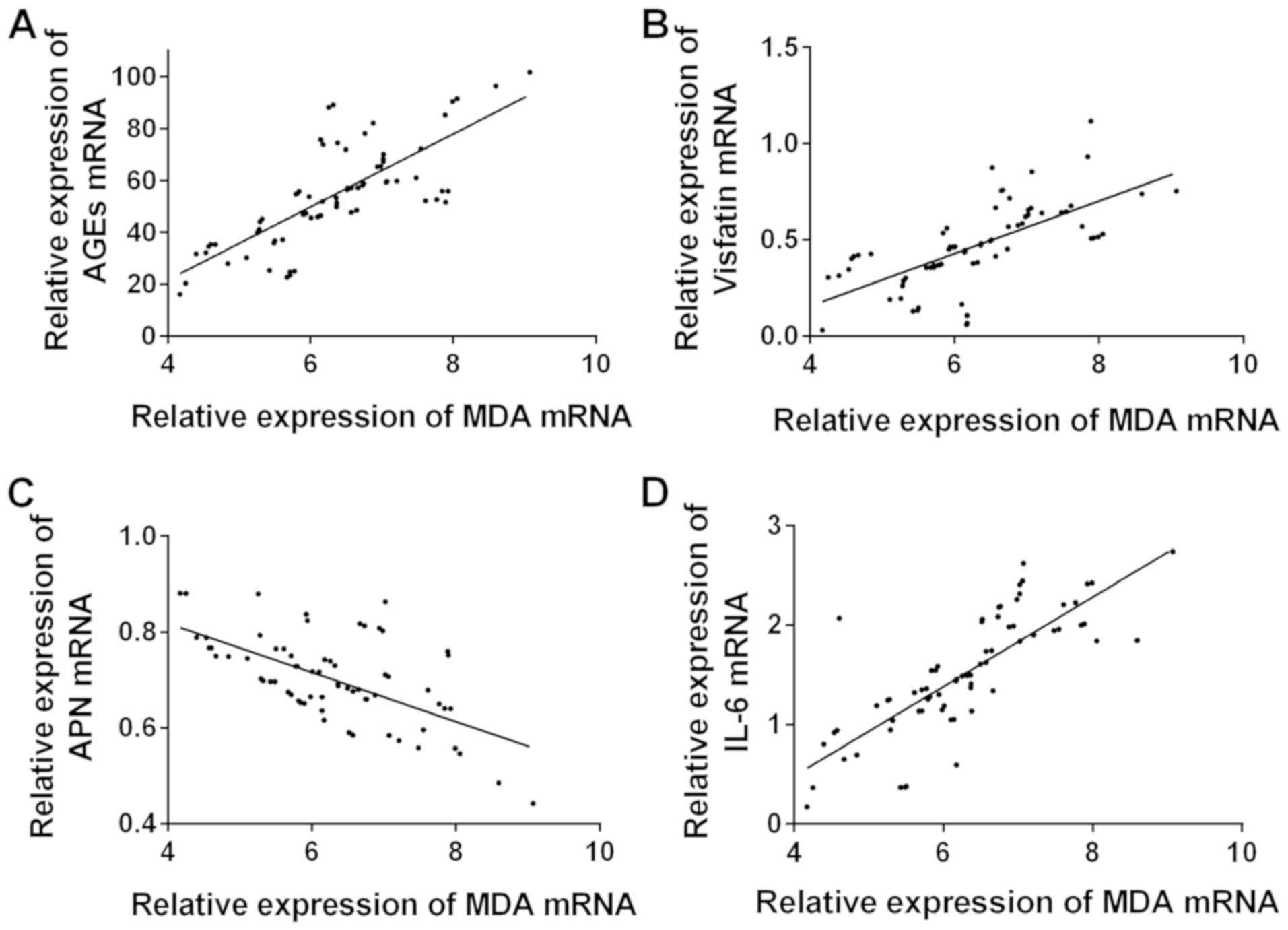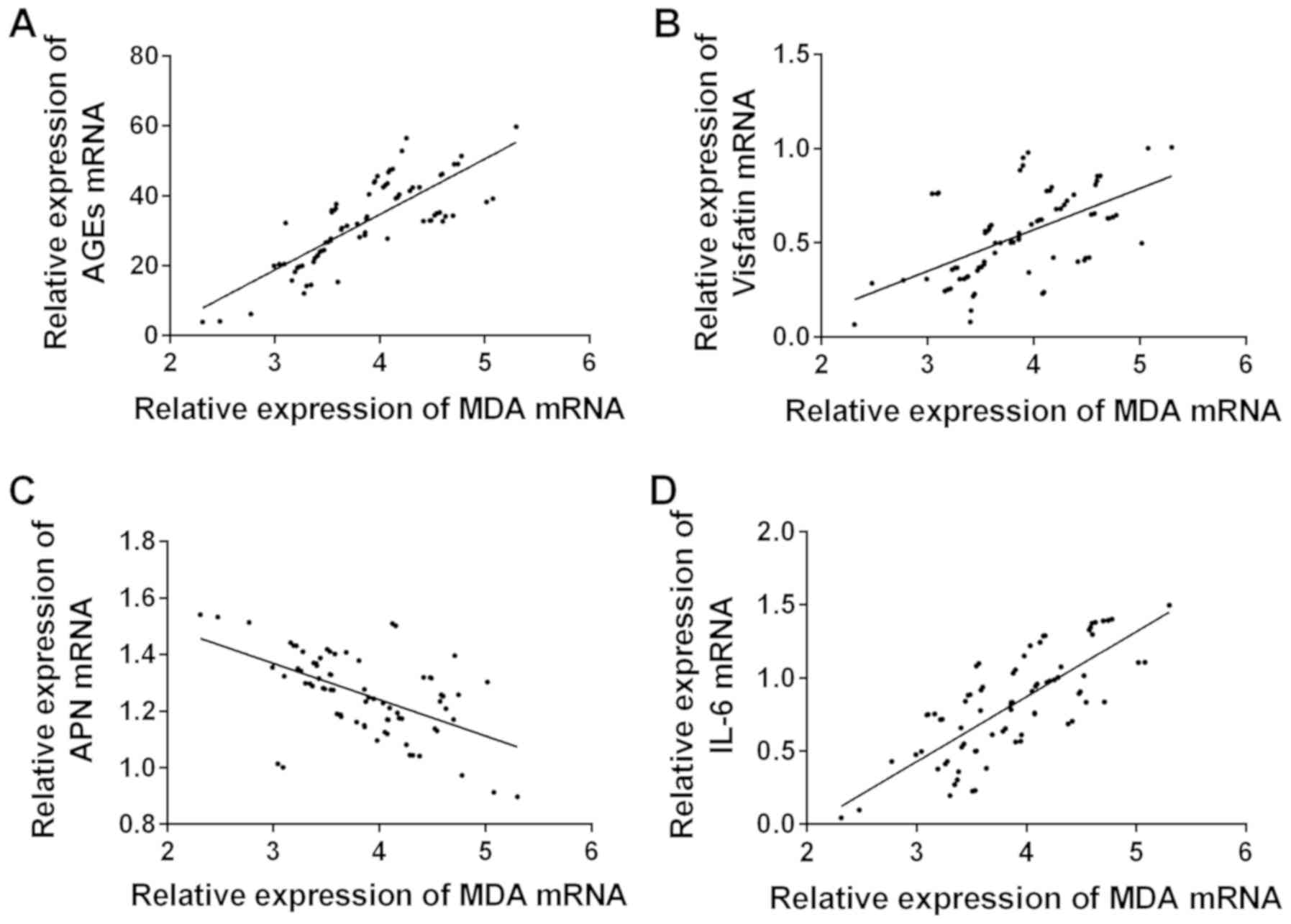|
1
|
Buchanan TA, Xiang A, Kjos SL and Watanabe
R: What is gestational diabetes? Diabetes Care. 30 (Suppl
2):S105–S111. 2007. View Article : Google Scholar : PubMed/NCBI
|
|
2
|
Ghodke B, Pusukuru R and Mehta V:
Association of lipid profile in pregnancy with preeclampsia,
gestational diabetes mellitus, and preterm delivery. Cureus.
9:e14202017.PubMed/NCBI
|
|
3
|
Kang MJ: The adiposity rebound in the 21st
century children: Meaning for what? Korean J Pediatr. 61:375–380.
2018. View Article : Google Scholar : PubMed/NCBI
|
|
4
|
Vargas-Terrones M, Nagpal TS and Barakat
R: Impact of exercise during pregnancy on gestational weight gain
and birth weight: An overview. Braz J Phys Ther. 23:164–169. 2019.
View Article : Google Scholar : PubMed/NCBI
|
|
5
|
Poprawski G, Pietryga M, Zawiejska A,
Iciek R, Wender-Ozegowska E and Brazert J: The impact of metabolic
control on uteroplacental circulation parameters in pregnancies
complicated by gestational hypertension and/or preeclampsia in
pregnant women with pregestational diabetes. Ginekol Pol.
86:811–820. 2015.(In Polish). View Article : Google Scholar : PubMed/NCBI
|
|
6
|
Schmidt AM: Highlighting diabetes
mellitus: The epidemic continues. Arterioscler Thromb Vasc Biol.
38:e1–e8. 2018. View Article : Google Scholar : PubMed/NCBI
|
|
7
|
Belfiore A, Malaguarnera R, Vella V,
Lawrence MC, Sciacca L, Frasca F, Morrione A and Vigneri R: Insulin
receptor isoforms in physiology and disease: An updated view.
Endocr Rev. 38:379–431. 2017. View Article : Google Scholar : PubMed/NCBI
|
|
8
|
van Rhijn-Brouwer FCC, Gremmels H,
Fledderus JO and Verhaar MC: Mesenchymal stromal cell
characteristics and regenerative potential in cardiovascular
disease: Implications for cellular therapy. Cell Transplant.
27:765–785. 2018. View Article : Google Scholar : PubMed/NCBI
|
|
9
|
Abell SK, De Courten B, Boyle JA and Teede
HJ: Inflammatory and other biomarkers: Role in pathophysiology and
prediction of gestational diabetes mellitus. Int J Mol Sci.
16:13442–13473. 2015. View Article : Google Scholar : PubMed/NCBI
|
|
10
|
Sudharshana Murthy KA, Bhandiwada A,
Chandan SL, Gowda SL and Sindhusree G: Evaluation of oxidative
stress and proinflammatory cytokines in gestational diabetes
mellitus and their correlation with pregnancy outcome. Indian J
Endocrinol Metab. 22:79–84. 2018.PubMed/NCBI
|
|
11
|
Badon SE, Zhu Y, Sridhar SB, Xu F, Lee C,
Ehrlich SF, Quesenberry CP and Hedderson MM: A pre-pregnancy
biomarker risk score improves prediction of future gestational
diabetes. J Endocr Soc. 2:1158–1169. 2018. View Article : Google Scholar : PubMed/NCBI
|
|
12
|
Low Birth Weight; Nephron Number Working
Group, : The Impact of kidney development on the life course: A
consensus document for action. Nephron. 136:3–49. 2017. View Article : Google Scholar : PubMed/NCBI
|
|
13
|
Lappas M, Permezel M and Rice GE: Release
of proinflammatory cytokines and 8-isoprostane from placenta,
adipose tissue, and skeletal muscle from normal pregnant women and
women with gestational diabetes mellitus. J Clin Endocrinol Metab.
89:5627–5633. 2004. View Article : Google Scholar : PubMed/NCBI
|
|
14
|
Ekun OA, Ogidi NO, Lawal RA, Ogunmuyiwa
OA, Umewune MC, Adefolaju FO, Oshundun MF and Oremosu AI:
Interrelationship between markers of oxidative stress, inflammation
and hematological parameters among preeclamptic Nigerian women. Med
Sci Monit Basic Res. 24:225–231. 2018. View Article : Google Scholar : PubMed/NCBI
|
|
15
|
Al-Gubory KH, Fowler PA and Garrel C: The
roles of cellular reactive oxygen species, oxidative stress and
antioxidants in pregnancy outcomes. Int J Biochem Cell Biol.
42:1634–1650. 2010. View Article : Google Scholar : PubMed/NCBI
|
|
16
|
Zhang C, Yang Y, Chen R, Wei Y, Feng Y,
Zheng W, Liao H and Zhang Z: Aberrant expression of oxidative
stress related proteins affects the pregnancy outcome of
gestational diabetes mellitus patients. Am J Transl Res.
11:269–279. 2019.PubMed/NCBI
|
|
17
|
Xin G, Du J, Wang YT and Liang TT: Effect
of oxidative stress on heme oxygenase-1 expression in patients with
gestational diabetes mellitus. Exp Ther Med. 7:478–482. 2014.
View Article : Google Scholar : PubMed/NCBI
|
|
18
|
Schäfer-Graf UM, Gembruch U, Kainer F,
Groten T, Hummel S, Hösli I, Grieshop M, Kaltheuner M, Bührer C,
Kautzky-Willer A, et al: Gestational diabetes mellitus (GDM) -
diagnosis, treatment and follow-up. Guideline of the DDG and DGGG
(S3 level, AWMF registry number 057/008, February 2018).
Geburtshilfe Frauenheilkd. 78:1219–1231. 2018.(In German).
View Article : Google Scholar : PubMed/NCBI
|
|
19
|
England L, Kotelchuck M, Wilson HG, Diop
H, Oppedisano P, Kim SY, Cui X and Shapiro-Mendoza CK: Estimating
the recurrence rate of gestational diabetes mellitus (GDM) in
Massachusetts 1998–2007: Methods and findings. Matern Child Health
J. 19:2303–2313. 2015. View Article : Google Scholar : PubMed/NCBI
|
|
20
|
Orr SK, Dachner N, Frank L and Tarasuk V:
Relation between household food insecurity and breast feeding in
Canada. CMAJ. 190:E312–E319. 2018. View Article : Google Scholar : PubMed/NCBI
|
|
21
|
Wells JCK, Figueiroa JN and Alves JG:
Maternal pelvic dimensions and neonatal size: Implications for
growth plasticity in early life as adaptation. Evol Med Public
Health. 2017:191–200. 2018. View Article : Google Scholar : PubMed/NCBI
|
|
22
|
Chen C, Gong W, Li C, Xiong F, Wang S,
Huang J, Wang Y, Chen Z, Chen Q, Liu P, et al: Sphingosine kinase 1
mediates AGEs-induced fibronectin upregulation in diabetic
nephropathy. Oncotarget. 8:78660–78676. 2017.PubMed/NCBI
|
|
23
|
Manigrasso MB, Juranek J, Ramasamy R and
Schmidt AM: Unlocking the biology of RAGE in diabetic microvascular
complications. Trends Endocrinol Metab. 25:15–22. 2014. View Article : Google Scholar : PubMed/NCBI
|
|
24
|
Briana DD and Malamitsi-Puchner A:
Reviews: Adipocytokines in normal and complicated pregnancies.
Reprod Sci. 16:921–937. 2009. View Article : Google Scholar : PubMed/NCBI
|
|
25
|
Moschen AR, Kaser A, Enrich B, Mosheimer
B, Theurl M, Niederegger H and Tilg H: Visfatin, an adipocytokine
with proinflammatory and immunomodulating properties. J Immunol.
178:1748–1758. 2007. View Article : Google Scholar : PubMed/NCBI
|
|
26
|
Galic S, Oakhill JS and Steinberg GR:
Adipose tissue as an endocrine organ. Mol Cell Endocrinol.
316:129–139. 2010. View Article : Google Scholar : PubMed/NCBI
|
|
27
|
Kukla M, Mazur W, Bułdak RJ and
Zwirska-Korczala K: Potential role of leptin, adiponectin and three
novel adipokines - visfatin, chemerin and vaspin - in chronic
hepatitis. Mol Med. 17:1397–1410. 2011. View Article : Google Scholar : PubMed/NCBI
|
|
28
|
Vozarova B, Weyer C, Hanson K, Tataranni
PA, Bogardus C and Pratley RE: Circulating interleukin-6 in
relation to adiposity, insulin action, and insulin secretion. Obes
Res. 9:414–417. 2001. View Article : Google Scholar : PubMed/NCBI
|
|
29
|
Decroli E, Manaf A, Syahbuddin S, Syafrita
Y and Dillasamola D: The correlation between malondialdehyde and
nerve growth factor serum level with diabetic peripheral neuropathy
score. Open Access Maced J Med Sci. 7:103–106. 2019. View Article : Google Scholar : PubMed/NCBI
|
|
30
|
Voinov VA: Therapeutic apheresis in
metabolic syndrome. Immunol Endocr Metab Agents Med Chem. 18:38–54.
2018. View Article : Google Scholar : PubMed/NCBI
|
|
31
|
Wang C, Guelfi KJ and Yang HX: Exercise
and its role in gestational diabetes mellitus. Chronic Dis Transl
Med. 2:208–214. 2016. View Article : Google Scholar : PubMed/NCBI
|
|
32
|
Pantham P, Aye IL and Powell TL:
Inflammation in maternal obesity and gestational diabetes mellitus.
Placenta. 36:709–715. 2015. View Article : Google Scholar : PubMed/NCBI
|
|
33
|
Ma Y, Cheng Y, Wang J, Cheng H, Zhou S and
Li X: The changes of visfatin in serum and its expression in fat
and placental tissue in pregnant women with gestational diabetes.
Diabetes Res Clin Pract. 90:60–65. 2010. View Article : Google Scholar : PubMed/NCBI
|
|
34
|
Luo JX, Liu XH, Zhang L and He GL: The
expression of visfatin in placenta in women with gestational
diabetes mellitus. Sichuan Da Xue Xue Bao Yi Xue Ban. 42:204–207.
2011.(In Chinese). PubMed/NCBI
|
|
35
|
Karacay O, Sepici-Dincel A, Karcaaltincaba
D, Sahin D, Yalvaç S, Akyol M, Kandemir O and Altan N: A
quantitative evaluation of total antioxidant status and oxidative
stress markers in preeclampsia and gestational diabetic patients in
24–36 weeks of gestation. Diabetes Res Clin Pract. 89:231–238.
2010. View Article : Google Scholar : PubMed/NCBI
|
|
36
|
Lappas M, Hiden U, Desoye G, Froehlich J,
Hauguel-de Mouzon S and Jawerbaum A: The role of oxidative stress
in the pathophysiology of gestational diabetes mellitus. Antioxid
Redox Signal. 15:3061–3100. 2011. View Article : Google Scholar : PubMed/NCBI
|
|
37
|
Sultan S, Alzahrani N and Al-Sakkaf K: The
postpartum effect of maternal diabetes on the circulating levels of
sirtuins and superoxide dismutase. FEBS Open Bio. 8:256–263. 2018.
View Article : Google Scholar : PubMed/NCBI
|
|
38
|
Bansal S, Chawla D, Siddarth M, Banerjee
BD, Madhu SV and Tripathi AK: A study on serum advanced glycation
end products and its association with oxidative stress and
paraoxonase activity in type 2 diabetic patients with vascular
complications. Clin Biochem. 46:109–114. 2013. View Article : Google Scholar : PubMed/NCBI
|
|
39
|
Brink HS, van der Lely AJ and van der
Linden J: The potential role of biomarkers in predicting
gestational diabetes. Endocr Connect. 5:R26–R34. 2016. View Article : Google Scholar : PubMed/NCBI
|
|
40
|
Dutta EH, Behnia F, Boldogh I, Saade GR,
Taylor BD, Kacerovský M and Menon R: Oxidative stress
damage-associated molecular signaling pathways differentiate
spontaneous preterm birth and preterm premature rupture of the
membranes. Mol Hum Reprod. 22:143–157. 2016. View Article : Google Scholar : PubMed/NCBI
|
















